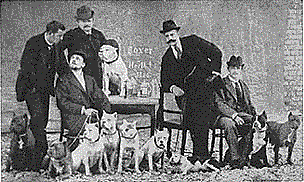To understand the white Boxer, you have to understand the origins of the modern Boxer. The first Boxer club (Deutscher Boxer Club) was formed in Munich, Germany in 1895. The founders of the club created the first Boxer Standard as a guide for future breeding and much of it remains in the Boxer breed standards of today.
And like dog people of today, they held their first dog show, entering their very finest breeding stock. As you can see from the surviving photo (left), many of those dogs were white. It is no surprise that white boxers make up about 20% of the total boxer population.
The modern Boxer Breed Standard (AKC) recites the only disqualification “Boxers that are any color other than fawn or brindle. Boxers with a total of white markings exceeding one-third of the entire coat.” Quite confusing!
How is it that a predominant coat color from the origins of the breed is now its only disqualification? For that, we need look no further than World War II. As you can imagine, the beginning of yet another war in the region, food became a scarce commodity. Dog owners had to prove their dogs did vital work in order to receive food rations. Boxers, being the intelligent free-thinking creatures they are, excelled as messenger dogs, pack-carriers, attack and sentry/guard dogs. As you can imagine, it is difficult to hide a white or even mostly white dog on the battlefield (day or night), so excessive white coat color became a disqualification.
With modern science we now understand that a white-presenting Boxer is not genetically “white” per se, but a colored (fawn or brindle) Boxer with excessive (sometimes to the point of full coverage) white markings. These dogs are in every way equal to their fawn and brindle brethren and should not be thought of as defective in any way.
Well, what about health-related issues? It is true that short-coated white dogs, including the Boxer, can suffer from sunburn which is easily remedied by sunscreen and limited exposure. White Boxers (as with other white animals) are also more prone than their colored counterparts to hereditary deafness due to a higher risk of carrying the gene for congenital sensorineural deafness (CSD), which is cause by improper
development of inner ear structures. From the National Library of Medicine: The Genetics of Deafness in Domestic Animals (September 8, 2015) https://pmc.ncbi.nm.nih.gov/articles/PMC4672198):
“Although deafness can be acquired throughout an animal’s life from a variety of causes, hereditary deafness, especially congenital hereditary deafness, is a significant problem in several species. Extensive reviews exist of the genetics of deafness in humans and mice, but not for deafness in domestic animals. Hereditary deafness in many species and breeds is associated with loci for white pigmentation, where the cochlear pathology is cochleo-saccular. In other cases, there is no pigmentation association, and the cochlear pathology is neuroepithelial. Late onset hereditary deafness has recently been identified in dogs and may be present but not yet recognized in other species. Few genes responsible for deafness have been identified in animals, but progress has been made for identifying genes responsible for the associated pigmentation phenotypes. Across species, the genes identified with deafness or white pigmentation patterns include MITF, PMEL, KIT, EDNRB, CDH23, TYR, and TRPM1 in dog, cat, horse, cow, pig, sheep, ferret, mink, camelid, and rabbit. Multiple causative genes are present in some species. Significant work remains in many cases to identify specific chromosomal deafness genes so that DNA testing can be used to identify carriers of the mutated genes and thereby reduce deafness prevalence.”
So, what does this mean for your common Boxer dog owner? Generally nothing. Your breeder should be able to let you know if that puppy can hear. If by chance that puppy is bilaterally deaf, there are lots of resources on how to effectively communicate and live happily with a deaf dog.



